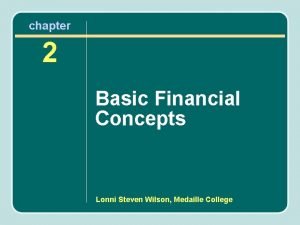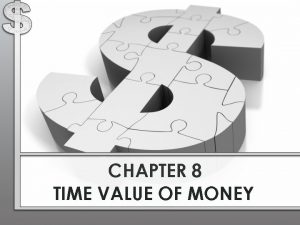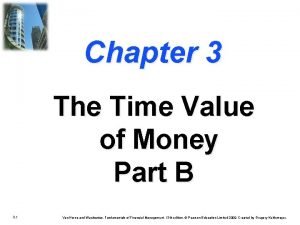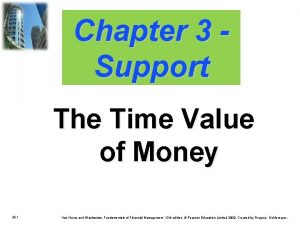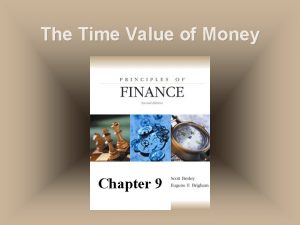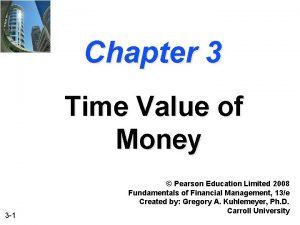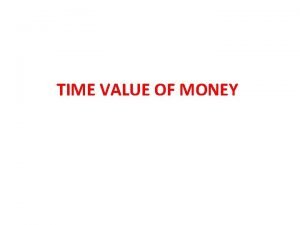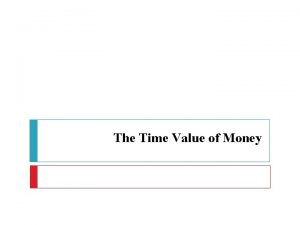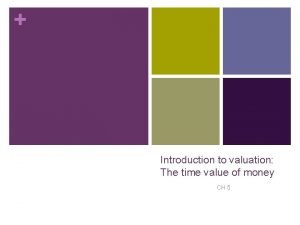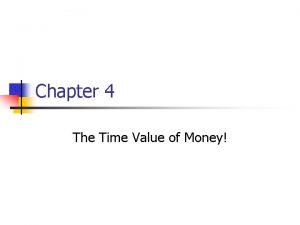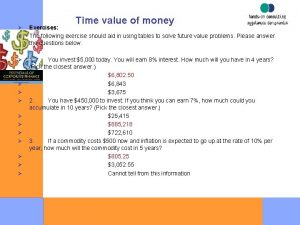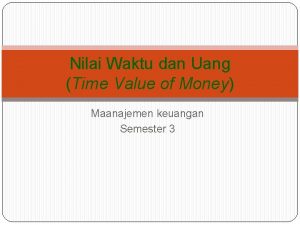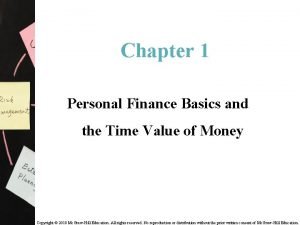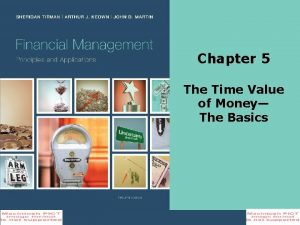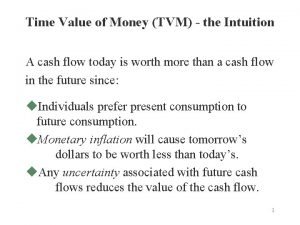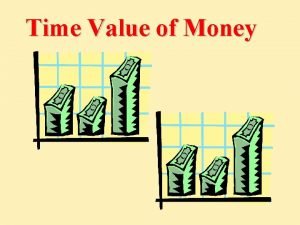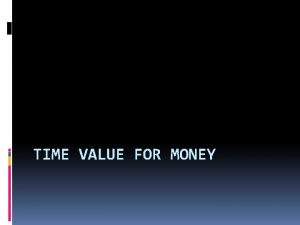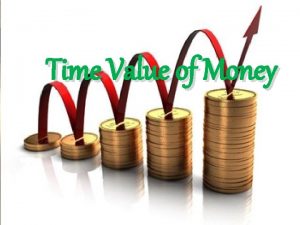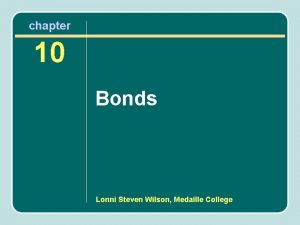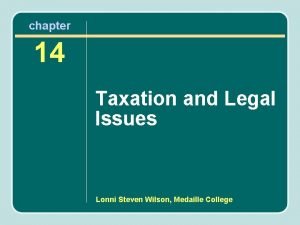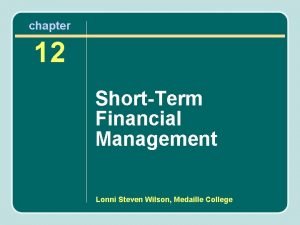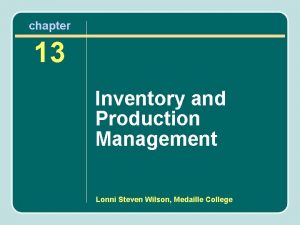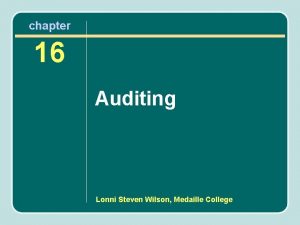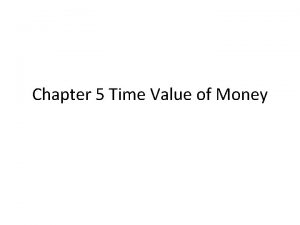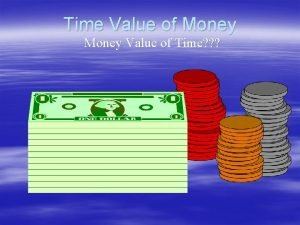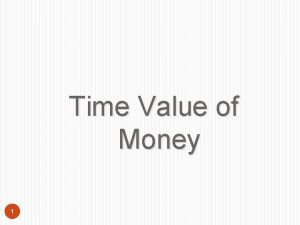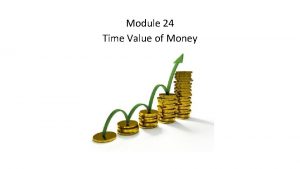chapter 6 Time Value of Money Lonni Steven





















- Slides: 21

chapter 6 Time Value of Money Lonni Steven Wilson, Medaille College

Key Chapter Objectives • Understand the concept of – and be able to calculate – future value. • Understand the concept of – and be able to calculate – present value. • Calculate the present value of multiple payments received in the future, including perpetuities and annuities. • Describe basic concepts of risk and return and their relationship to computing the present value of future payments.

The Value of Money • How much is money worth? • The value of the dollar one receives today is worth more than the value of the dollar one receives in the future. Time value of money: Represents the concept that the value of money in today's dollars decreases in value the further out into the future it is expected to be received (continued)

The Value of Money (continued) Future value • The value of an initial lump sum of money after it is invested over one or more periods of time. • The opposite of future value is present value. Present value • The current value of a future amount of money. • If you win the lottery, you might be able to take several million now or 10 times that amount over a number of years. Such payouts are based on the fact that if you invest a certain sum now, it will be worth more in the future.

Discount Rate The interest rate or percentage return that can be earned on an initial amount of money. For example, if a 5% annual return on a one-year CD would yield $102, 500, then a payment of $102, 500 earned in one year is also valued at $97, 619 today. • In other words, a company would find $97, 619 paid today or $102, 500 paid one year from today as equally acceptable alternatives. • If paid $97, 619 today, the company could place the money in the one-year CD at 5% and receive $102, 500 in one year.

Compounding The process of holding the stock and accruing a further return over the second year Compound interest • With many loans, interest is added to the principal loaned amount over the loan’s life. • If you borrowed $100 at 10% interest compounded annually, you would owe $110 after the first year, $121 for the second year ($110 x 110%), $133 for the third year ($121 x 110%), and so on throughout the life of the loan (if you were making no payments).

Calculating Future Value The following formula can be used to calculate future value: FV = C 0 x (1 + r)t FV = future value (i. e. , the value of an initial lump sum of money after it is invested over one or more periods of time) C 0 = the initial amount of cash that is invested today r = the interest rate or rate of return t = the number of years over which the cash is invested (continued)

Calculating Future Value (continued) Table A. 1 in appendix A presents future values of $1 at the end of t periods (i. e. , a variable number of time periods into the future over which the $1 is earning interest). To use the table, locate the appropriate interest rate or return on the horizontal axis and the appropriate number of periods on the vertical axis. (continued)

Calculating Future Value (continued) Using the formula to solve for FV Assuming you started out with $500 and earned an 8% annual return over two years, calculate FV. • Here, (1 + r)t can be found in appendix A, table A. 1; locating the period of two years on the vertical axis and the 8% interest rate on the horizontal axis results in the number 1. 1664. Thus. . . • FV = C 0 x (1 + r)t FV = 500 x 1. 1664 = $583. 20

Calculating Present Value The following formula can be used to calculate present value over more than one period in the future: PV x (1 + r)2 = FV PV = present value r = annual rate of return t = number of years FV = future value (continued)

Calculating Present Value (continued) Using the formula to solve for PV • Swish James has signed a contract that includes $2 million in deferred compensation that will be paid at the end of two years. • What is the present value of this contract if he could earn a 4% annual return on his money? PV x (1 + r)2 = FV PV x (1+ 0. 04)2 = $2, 000 PV x (1. 04)2 = $2, 000 PV = $2, 000 / (1. 04)2 = $2, 000 / 1. 0816 = $1, 849, 112 The present value of $2 million received in two years is $1, 849, 112. (continued)

Calculating Present Value (continued) An alternative way to calculate the results obtained is to use table A. 2 in appendix A in order to obtain a present value factor. • To use the table, locate the appropriate number of periods on the vertical axis and the interest rate on the horizontal axis. • In our example, the number of periods is 2 and the interest rate is 4%. • Thus the present value factor is 0. 9246. • If we multiply $2 million by the present value factor 0. 9246, we find that the present value of $2 million received in two years is $1, 849, 200.

Perpetuity A single cash flow per year forever into the future • The concept of a perpetuity comes into play when valuing preferred stock since the price of a preferred share is equal to the present value of expected constant dividends that will be paid each year forever into the future. • The present value of a perpetuity is equal to PV = C / (1 + r) + C / (1 + r)2 + C / (1 + r)3 +. . . C = a constant annual cash flow r = the interest rate or rate of return • Which may be simplified as PV = C / r

Calculating the Present Value of Perpetuities Assume that the perpetuity pays $100 per year at an interest rate of 8%; then the present value of the perpetuity is $1, 250. PV = $100 / 0. 08 = $1, 250 If interest rates fell to 6%, the present value of the perpetuity would be $1, 666. 67. PV = $100 / 0. 06 = $1, 666. 67

Annuity A constant stream of payments that is received for a fixed number of periods • Annuities are common in the real world – home mortgages, leases, and pensions paid at retirement are all examples of annuities. • The present value of an annuity is equal to PV = C / (1 + r) + C / (1 + r)2 +. . . + C / (1 + r)t C = constant cash flow period r = annual rate of return t = number of periods during which the cash flow will be received • Which may be simplified as PV = C{1 − [1 / (1 + r)n]} / r • In which n = number of periods during which the cash flow will be received

Calculating the Present Value of Annuities A coach (Eric Mangini, see sidebar in text) signs a contract that pays $2. 5 million in salary for five years. For our purposes, this is treated as a fiveyear annuity. How much is the present value of this contract when signed? Assuming a discount rate of 7%, PV = $2, 500, 000 x {1 − [1 / (1. 07)5]} / 0. 07 = periodic payment x annuity factor = $2, 500, 000 x 2. 6243 = $6, 560, 750 (continued)

Calculating the Present Value of Annuities (continued) We could also use table A. 3 in appendix A. • Again, interest rates are shown on the horizontal axis, and periods are shown on the vertical axis. • Consulting the table, we see that for an interest rate of 7% and an annuity that is received for five periods, the present value factor is 4. 1002, which we obtained in the calculation in the example on the previous slide.

Key Terms risk—Uncertainty concerning the future cash flows. discount rate—The interest rate or percent return that can be earned from an investment. The discount rate is used when determining the present value of an investment option.

Risk and Choice of Discount Rate When we calculated the present value of future cash flows, we did not discuss how to choose a discount rate. • The choice of discount rates is tied to the risk of the future cash flows. • Will Mangini actually receive all of that compensation? • To do so, he has to remain head coach of the Jets for five years. A common way to adjust for uncertainty is to use a discount rate that reflects the riskiness of the cash flows. We use higher discount rates when there is greater riskiness associated with the cash flows being valued.

Key Terms capital gains—The total gains in value of an investment, excluding dividends. However, dividends can be included in the capital gains if the dividends are reinvested in additional shares of the same stock. capital losses—All realized losses from an investment. long-term capital gains or losses—Investments that have matured for more than one year and result in capital gains or losses that must be reported to the IRS. short-term capital gains or losses—Applies to investments held for less than one year.

Questions for In-Class Discussion 1. There has been increased criticism of corporate executives for being too short-term oriented and not focused enough on the long-run performance of their companies. Should companies place an emphasis on maximizing long-term profits? 2. There has been increased criticism of corporate executives for being too short-term oriented and not focused enough on the long-run performance of their companies. Should there be an emphasis by companies on maximizing long-term profits?
 Lonni wilson
Lonni wilson Money money money team
Money money money team Chapter 8 time value of money answer key
Chapter 8 time value of money answer key Firmilate
Firmilate Chapter 3 time value of money problem solutions
Chapter 3 time value of money problem solutions Chapter 2 time value of money solutions
Chapter 2 time value of money solutions Chapter 3 time value of money problem solutions
Chapter 3 time value of money problem solutions Contoh time value of money
Contoh time value of money What are the objectives of time value of money
What are the objectives of time value of money Introduction to valuation the time value of money
Introduction to valuation the time value of money Time value of money quiz
Time value of money quiz Time value of money exercise
Time value of money exercise Faktor yang mempengaruhi time value of money
Faktor yang mempengaruhi time value of money Diskusi tentang time value of money
Diskusi tentang time value of money Personal finance basics and the time value of money
Personal finance basics and the time value of money Time value of money
Time value of money Time value of money
Time value of money Pengertian time value of money
Pengertian time value of money Contoh value creation
Contoh value creation Gatsby setting
Gatsby setting Money smart money match
Money smart money match Money on money multiple
Money on money multiple
